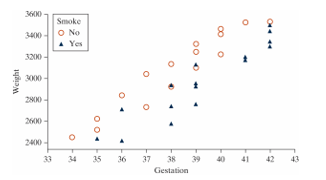Babies born with low birth weights (less than 2500 grams) are at an increased risk for many infant diseases. Researchers in North Carolina collected data to see what variables may influence the birth weight (in grams) of a child, including whether the mother drank alcohol during pregnancy, whether the mother smoked during pregnancy, the mother's age (years) , the gestation of the pregnancy (number of weeks from conception until birth) , the mother's race, the length of the birth (hours) , and several others. The plot below summarizes some of the variables measured. 
-How would the correlation coefficient between birth weight and gestation period computed from all women in the sample compare to the correlation coefficient between birth weight and gestation period computed from only non-smoking women?
A) The correlation coefficient for the entire sample would be closer to 1 than the correlation coefficient for the non-smoking group.
B) The correlation coefficient for the entire sample would be closer to 0 than the correlation coefficient for the non-smoking group.
C) The correlation coefficient for the entire sample would be the same as the correlation coefficient for the non-smoking group.
D) We cannot determine how the two correlation coefficients compare based on this plot.
Correct Answer:
Verified
Q1: Babies born with low birth weights (less
Q2: Babies born with low birth weights (less
Q3: Babies born with low birth weights (less
Q4: Babies born with low birth weights (less
Q6: Babies born with low birth weights (less
Q7: The following scatterplot displays the finish time
Q8: The following scatterplot displays the finish time
Q9: The following scatterplot displays the finish time
Q10: The following scatterplot displays the finish time
Q11: Which of the following plots has the
Unlock this Answer For Free Now!
View this answer and more for free by performing one of the following actions

Scan the QR code to install the App and get 2 free unlocks

Unlock quizzes for free by uploading documents